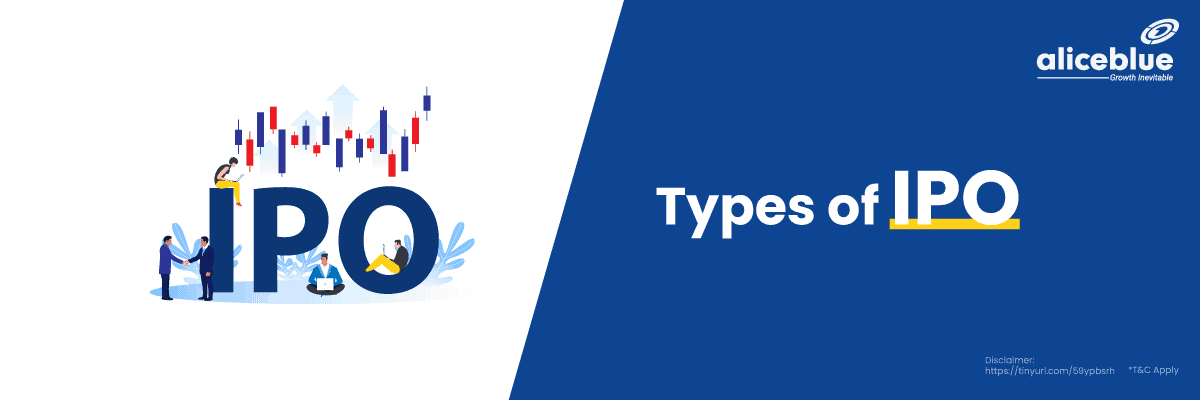The main types of Initial Public Offerings (IPOs) are Fixed Price Issues and Book Building Issues. Fixed Price Issues sell shares at a predetermined price, while Book Building Issues set the price according to investor demand, offering varied routes for companies to go public.
Content :
- IPO Full Form
- Types of IPO
- Fixed Price Issue vs Book Building Issue
- How to Apply for an IPO?
- Different Types of IPO – Quick Summary
- Types of IPO – FAQs
IPO Full Form
The full form of IPO is Initial Public Offering. This is when a private company can become a public company by selling its shares to the public for the first time. An IPO is a significant step for a company as it opens the door to raising capital from a wide base of investors.
An IPO is not just a means of raising capital; it’s a transformative event with regulatory requirements, increased transparency, and the opportunity to enhance the company’s prestige and public profile. It often leads to greater liquidity and provides a broader capital market access.
Types of IPO
There are primarily two types of Initial Public Offerings (IPOs): Fixed Price Issues and Book Building Issues. In a Fixed Price Issue, the price of the shares is predetermined, while in a Book Building Issue, the price is discovered through the process of bidding.
- Fixed Price Issue: In this type of IPO, the company sets the issue price and discloses it to the investors at the start of the process.
- Book Building Issue: Here, the company offers a price range, and investors bid for shares at different prices within the range. Based on investor demand, the final price is determined after the bid closing date.
Fixed Price Issue vs Book Building Issue
The primary difference between Fixed Price Issue and Book Building Issue is that in a Fixed Price Issue, the price is set and known to investors from the start. In contrast, in Book Building Issues, the price is discovered through a bidding process within a price band.
Here’s a table summarizing the differences:
| Feature | Fixed Price Issue | Book Building Issue |
| Pricing | The share price is determined and declared upfront. | The price is discovered through a bidding process within a price band. |
| Price Discovery | Price is set by the company and remains constant, regardless of demand. | Allows market dynamics to determine the final price based on investor demand. |
| Investor Knowledge | Investors know the price before they apply. | Investors only have a price range and bid within it, knowing the final price after book closure. |
| Subscription | Investors pay the full share price when they apply. | Investors bid for shares and pay the price only after allocation. |
| Flexibility | Less flexible, as it doesn’t account for market demand fluctuations. | More flexible, as it adapts to the market’s current valuation of the shares. |
| Market Perception | Considered traditional and less dynamic. | Viewed as more market-driven and modern. |
How to Apply for an IPO?
To apply for an IPO, investors typically must go through a brokerage firm like Alice Blue. For instance, using an online brokerage platform like Alice Blue, investors can apply for IPO shares through a process known as ASBA (Application Supported by Blocked Amount).
- Open a Demat account with a brokerage like Alice Blue.
- Log in to your brokerage account and select the IPO you wish to apply for.
- Fill in the application form with the required details.
- Specify the number of shares and bid price (for Book Building Issues).
- Apply after agreeing to block the amount in your bank account.
- Wait for the allocation after the bidding process is complete.
To understand the topic and get more information, please read the related stock market articles below.
| Deemed Prospectus |
| Shelf Prospectus |
| Capital market meaning |
| Book building |
| Issue Price |
| Non institutional investors |
| Qualified Institutional Buyer |
| Over Subscription Of Shares |
| Under Subscription Of Shares |
Different Types of IPO – Quick Summary
- The main types of IPOs are Fixed Price and Book Building Issues.
- IPO or Initial Public Offering is where a private company sells shares to the public for the first time, raising capital and gaining market access.
- The key difference is in pricing between Fixed Price issue and Book Building issue; Fixed Price is set, while Book Building is market-determined.
- You can apply for an IPO through a brokerage like Alice Blue, where investors complete an ASBA application, bid on shares, and have funds blocked until share allocation.
- Invest in IPOs for free with Alice Blue. They provide a Margin Trade Funding facility, where you can use 4x margin to buy stocks i.e. you can buy stocks worth ₹ 10000 at just ₹ 2500.
Types of IPO – FAQs
What are the different types of IPO markets?
The IPO markets are generally categorized into primary and secondary markets. In the primary market, companies issue new shares to the public. The secondary market is where these shares are then traded among investors.
How many categories are there in IPO?
There are two main categories of IPOs: Fixed Price Issues and Book Building Issues. These categories define how the share price is set and how investors can apply for the shares.
What are the types of IPO and FPO?
An IPO, or Initial Public Offering, refers to the process of a company offering shares to the public for the first time. An FPO, or Follow-on Public Offer, is when an already public company issues additional shares to investors.
What is the limit of an IPO?
The limit of an IPO can refer to the maximum number of shares a company offers to the public, the price range for the shares, or the portion of shares allocated to different investor categories. Regulatory bodies may also limit how much an individual investor can apply for in an IPO.
We hope that you are clear about the topic. But there is more to learn and explore when it comes to the stock market, commodity and hence we bring you the important topics and areas that you should know:






